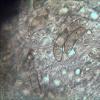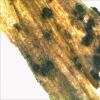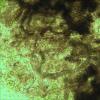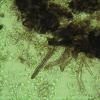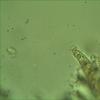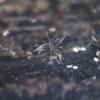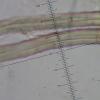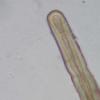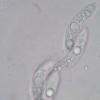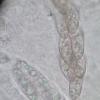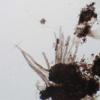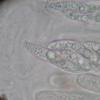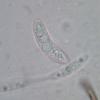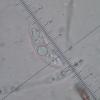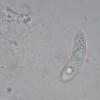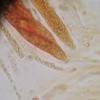
23-01-2016 23:37
 Rubén Martínez-Gil
Rubén Martínez-Gil
Hola a todos. Subo unas fotos de Trichopeziza "pe

23-01-2016 19:45
 Joop van der Lee
Joop van der Lee
Found on deer dung.Fruitbody: Hyaline white; matur

18-01-2016 00:58
 Rubén Martínez-Gil
Rubén Martínez-Gil
Hola a todos. Ayer tambié encontré estos ejempl

18-01-2016 20:34
Someone can get, the following literature:Kušan,I

22-01-2016 13:45
 Joop van der Lee
Joop van der Lee
Found on rabbit dung. Fruitbody: 248x182 um.Asci:

Dear all,
found today on an lying dead stem of Fagus, initial stage of decomposition.
Macroscopically I first thought it might be something like Lasiosphaeria hirsuta, but the spores a different and quite striking.
Spores becoming slightly brownish with age, bean-shaped, 27-32 x 8,5-11 µm, with two or three big oil drops.
Asci without reaction on Lugols/Barals.
Has anyone an idea were to search for?
thank you and best regards,
Andreas
could be something like Helminthosphaeria stuppea (formerly Lasiosphaeria s.). Have a look at this paper: http://www.ascofrance.fr/uploads/forum_file/Helminthosphaeriaceae-Miller-et-al-Mycologia2014-0001.pdf.
Best wishes,
Gernot

Dear Gernot,
thank you very much, that looks very promising!
May be Jacques can confirm this :-)
best regards,
Andreas

Hallo Gernot,
wieso kennst Du diese Art eigentlich?
Ich wollte mal etwas darüber recherchieren, aber die Art ist noch nicht mal in unserem TaxRef-Liste für Deutschland enthalten - scheint also neu für Deutschland zu sein?!
beste Grüße,
Andreas

this would be my guess too, around H. stuppea.If you read the Mycologia paper you will see that the delimitation of these species is not fully resolved.
Good luck!
Jacques

Dear Jacques,
thanks a lot!
Not fully resolved means, that it is not certain that the european collections are identical to the american ones. But the european collections are identical one to each other, isn't it?
Is this a rare species? I don't find anything in german language on that species ....
best regards,
Andreas

Jacques
just a few weeks ago we had a collection of a "typical" H. stuppea, i.e. one that fits the description in the Mycologia article quite well. Unfortunately I won't have access to the photos of this collection until next week so I can't show them right now.
And a few years back I found a species that came close to H. stuppea but had deviating ascospores. That was the collection that intruduced me to this intricate group. :-)
Best wishes,
Gernot


